Load Bearing Wall Removal Cost
Last updated 16th September, 2025
Trying to find out how much it costs to knock down load bearing walls?
In this price guide you'll find out all you need to know about wall removal prices and the load bearing wall removal cost (on average, it will set you back between £1,200 and £1,750).
Read the complete guide on knocking down internal walls below!
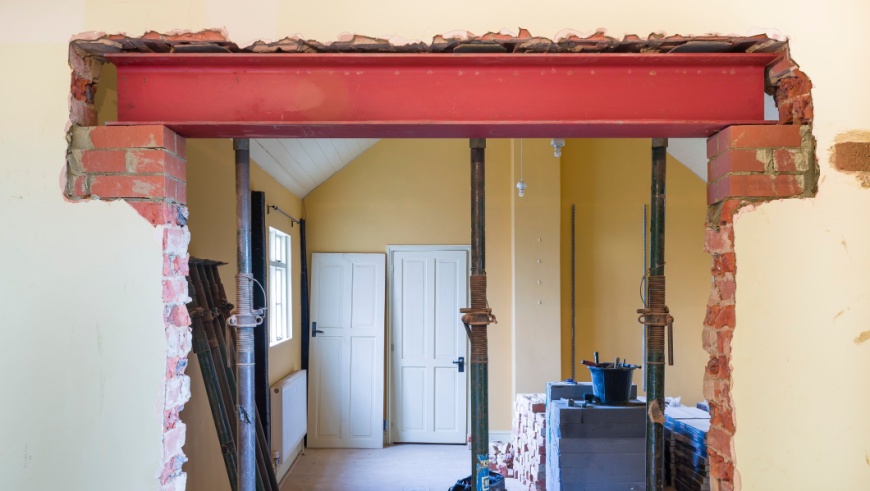
Table of Contents
- How much to knock down a wall?
- Additional costs of removing load bearing walls
- Labour cost of knocking down an internal wall
- What does removing a load bearing wall involve?
- Factors that impact the cost of removing a load-bearing wall
- Can I remove a load-bearing wall myself?
- Planning permission and building regulations
- Fire regulations
- Party wall
- How to check whether a wall is load-bearing
- What are the reasons to remove a load-bearing wall?
- Will I need a lintel?
- What can go wrong?
- FAQs
- How to find & hire a load-bearing wall contractor
- Sources
How Much to Knock Down a Wall?
The average cost of removing a load-bearing wall is usually around £1,200 to £1,750, although quotes can vary depending on location and the size of the building company that's doing the job. For example, in London, you could pay up to £2,500 or for more complex projoects the cost may rise to between £3,000 and £3,500.
What other factors need to be considered?
If you want to remove a load-bearing wall, you may have to obtain a party wall agreement, which will be an additional cost. Also, keep in mind that when living in a terraced home or semi-detached property, you'll be sharing a wall with your neighbours.
Additional costs not included within this estimate include jobs such as installing an additional radiator, which is priced anywhere from £65 to £300 or moving an existing one at a cost of around £150 to £400 (depending how straightforward the job is). The moving of light switches and power sockets are another consideration, which will also cost around £85 to £150.
You may wish to remove walls for several reasons. However, in the UK the most common is to knock down a wall between the kitchen and dining room or to expand the living room. Although another popular choice is the stud wall under the staircase, as this isn't load baring and generally fairly cheap by comparison
Load Bearing Wall Removal Prices
If you're wondering how much knocking down internal walls costs, here are a few average prices to help you understand the financial aspects. Although end prices will vary depending on the size of your wall and other factors such as the need for structural support, any structural damage that needs repairing and the location of your property.
| Job Description | Avg. Cost |
|---|---|
| Single doorway - around 1m | £1,250 |
| Double doorway - around 2m | £1,500 |
| Medium open plan - around 4m | £1,750 |
| Large open plan - around 6m | £2,200 |
Additional Costs of Removing Load Bearing Walls
Along with the cost of removing an internal wall, there are other areas to consider in your budget.
Hanging Internal Doors
If you have removed the wall in order to fit an internal door, this usually costs around £240 depending on the type and design you choose. If you already have one at the alreeady, the cost of hanging a door typically falls between £50 and £100 although price may vary for anything more complex.
Flooring Costs
Another furnishing cost is flooring, especially if you have chosen to open up the area by knocking down a wall. You could simply add flooring in the unfurnished room to keep your costs low or have a brand new floor installed throughout. The most popular options include solid wood (£15 to £80 per m²), tile, laminate (£5.50 to £20 per m²) and carpet (£12 to £60 per m²).
Moving a Radiator
After the wall has been taken down, moving a radiator is a good idea to ensure even heat distribution throughout your room.
Therefor, you may want to consider if you need the help of a professional plumber to reposition your radiators, which can cost around £150 based on a 2-hour job.
You can keep costs down if radiators can be moved to existing pipework, but in the event new pipework is needed the average cost is estimated at £3.50 per square metre.
Electrician Costs
Electrician prices may vary depending on the job. Although having removed an internal wall, it may be you then need to move a light switch or socket. The typical rate for this around £100 to £150 a day.
Some electricians charge just for the job, which may depend on the contractor you choose and the difficulty of the excercise, especially if you need other work carried out at the same time.
Waste Removal
Waste removal is another important cost, especially if you plan to get rid of it yourself. To do this, you will need to consider skip hire cost which is usually around £250 to £450 for a 6-yard skip and £260 to £385 for an 8-yard skip.
Larger sizes are also available, although it is unlikely you will need anything much bigger unless the removal of an internal wall is part of a larger renovation project.
Load Bearing Wall Removal Cost Breakdown Calculator
Individual Costs For Hiring a Company To Remove a 4m Load-Bearing Wall: £1,750
Materials
£525
Tradesmen
£1,050
Waste Removal
£175
Labour Cost of Knocking Down an Internal Wall
The majority of builders charge around £150 to £250 per day, although this can reach £400 to £500 per day in higher cost areas such as London and the South East.
Builder will also often work in pairs, which will then increase labour costs - especially when knocking down internal walls. Including RSJ insertions, the task usually takes around 1 to 2 days in order to complete.
You may also require the help of a structural engineer who is able to calculate the required strength of an RSJ. Structural engineer prices are usually between £200 to £500 per visit (with the higher end representative of costs in areas such as London).
Once completed, you may need a plasterer to finish off the job, costing around £150 to £250 per day. The time spent on plastering the room will depend on its size, although the average time frame is around 6 to 12 hours for a single or double doorway and up to 1 day for an open plan doorway or archway.
What Does Removing a Load Bearing Wall Involve?
People often wonder how to knock down a wall between two rooms, so here is a guide to help you understand the process.
To knock through an existing wall between kitchen and dining room for example, an initial inspection is required by a builder to check electrics, pipework and the load. This is usually followed by an inspection by a structural engineer.
This can cost anywhere from £200 for a single check and £600 for multiple visits. During the inspection, they will assess the wall and calculate the correct rating for the load-bearing joist that will support the upper floor (the RSJ or lintel beam).
Before the wall is removed, all personal items, small furniture and decorations should be removed to prevent dust-build-up. Plastic sheets will be placed on large furniture and the floor and hung on walls to prevent dust debris. Some contractors may use zip walls to protect doorways and other rooms from dust interference, making sure that only one doorway is used to enter and exit.
Vents may also be blocked off with plastic coverings to prevent dust from blowing into other spaces, or you may be advised to switch your system off entirely.
Once wall demolition has been approved by building control, a supporting RSJ beam must be fitted to support the roof structure. If you live in a terrace or semi-detached home, where new beams will need to be installed in a party wall adjacent to your neighbour, you may need to speak to a surveyor who will advise you on the legal process for this.
Once all is approved, the wall can then be removed starting with the plaster, followed by the wall panels which can be removed by hand or with a drill. A header will then be implemented to hold the weight of the joist once the rest of the wall structure is removed.
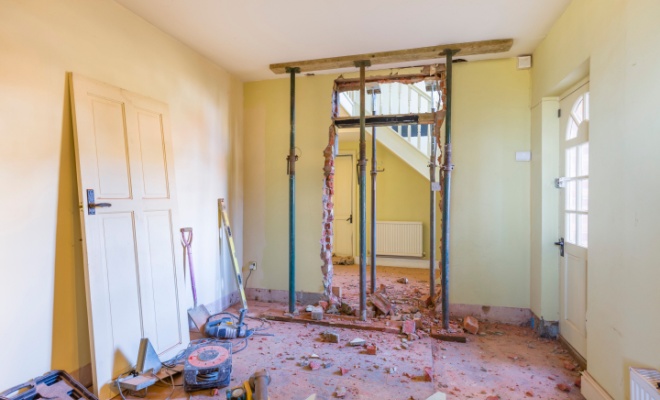
After the wall is removed, any dust will be cleared by using an extractor or a hoover. Any excess materials will also be put into a skip, which will then be taken to your local waste recycling centre or if the materials are fairly new they can be used for another building project in your home.
Factors That Impact the Cost of Removing a Load-Bearing Wall
Several factors can affect the cost of removing a load-bearing wall, especially depending on the scale of the job. For example, knocking down a wall between two rooms to create a more open space can cost up to £1,750, while installing a single doorway typically costs around £1,250.
Another consideration is the cost of installing a rolled steel joist (RSJ), which is required to support the structure during demolition.
If you’re only planning to knock through a wall for a 1-metre single doorway, you should expect to pay a material cost of £800. Whereas for a larger open-plan space, the cost could rise to £950. The final price will depend on the type of RSJ selected, as thicker beams tend to be more expensive.
In addition to the cost to knock down an internal wall, other tasks should also be considered, such as professional waste removal. This can typically costs around £100 to £175, depending on the amount of waste generated.
If you're working with an older house, you may also need to level out your floor, as the levels on either side of the removed wall may not match perfectly. This typically costs between £10 and £200 per square metre, depending on the materials used.
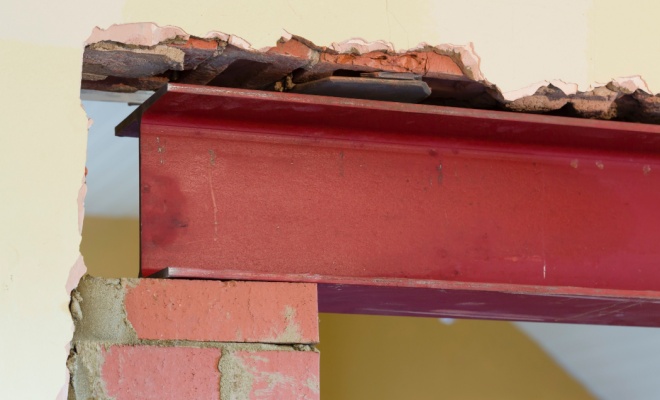
You will also need to look into redecorating costs, especially on your walls, although prices for this vary massively depending on the type of room, the size, materials and labour costs.
Say, for instance, you have removed a wall to expand your kitchen and dining room, you may want to wallpaper the room which could cost around £175 to £600 for material and labour costs, depending on the paper you opt for.
If you’re on a budget, you may want to paint instead, the price ranges anywhere between £150 to £500 for a professional painter and decorator to do the job but this could be a job that you do yourself if you are capable.
Can I Remove a Load-Bearing Wall Myself?
It is possible to bring the cost of removing a load bearing wall down by doing it yourself. However, you may want to bring in a structural engineer who will work out the positioning of the support beam to ensure the structure remains intact.
You should then employ a professional builder to install an RSJ and conduct the demolition work. By employing professionals to do the job, you can rest assured knowing that everything will be completed as it should within the correct legal provisions. It will also help reduce how much it costs in the long run, as a professional job knocking down a wall will help prevent any extra costs related to structural complications.
There are some apects that you can easily complete yourself, such as covering the room with protective plastic to minimise dust debris. Although, you should also try to wear a dust mask, protective goggles and sensible clothing before tackling any small jobs.
This could include removing the plaster, masonry and skirting boards. This will require you to use a hammer and chisel or you may want to invest in a drill that will ensure the job gets done quickly.
Planning Permission and Building Regulations
Planning permission is not typically required to remove a load-bearing wall, as it falls under permitted development rights. However, one exception is if you live in a listed building, as in this instance you would need to apply for permission (costing around £200) via your local authority.
As for building regulations, you can apply through your local council to have the project reviewed, which for removing an internal wall can cost up to £650 based on a project under 10 square metres.
Note actual costs may vary depending on your local council and the size of the work required.
If consent is given, you will receive a building notice which will allow you to get started. While hiring a structural engineer isn't a legal requirement, it is highly recommended for removing load-bearing walls as they can confirm the work meets the necessary safety and compliance standards.
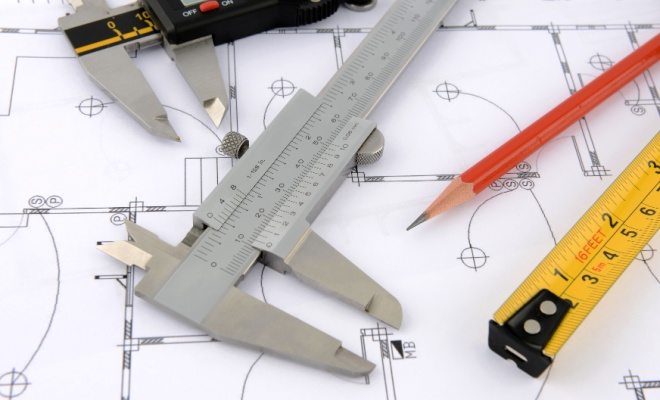
Once the work is complete, you must inform the building control body who will then issue a completion certificate, which will confirm the changes to your property.
If you do not obtain a building notice or a certificate, then you may find it difficult should you decide to sell your home. As estate agents tend to slow down the house sale process due to a lack of authorisation on previous projects.
To speed up the process, you can obtain a regularisation certificate, which involves certifying building work after it is complete. This typically costs around £300 to £500 and approval will be given within 8 weeks, providing any unauthorised work meets the correct standards.
Fire Regulations
To ensure your wall removal meets fire safety standards, you need to make sure that the steel beam used has at least 30 minutes of fire resistance. The common way to do this is by installing two or more layers of secured plasterboard.
A timber beam’s resistance should be calculated by a structural engineer and tested on its level of fire resistance. If using a concrete beam, you will more than likely be resistant already, as the majority of concrete beams feature steel, although you need to make sure the concrete adequately covers that.
If living in a two-storey home, you may already be covered by smoke alarms and egress windows on the above floors, however, in homes with three-storeys or more, this may not be the case. This means you may have to purchase new smoke alarms and install egress windows to ensure the safety of the new space.
When knocking down a wall to add in a new doorway, then you will need to make sure that all fitted doors are self-closing and highly fire-resistant, especially doors that separate the stairway from a room.
Party Wall
For those living in a terraced or a semi-detached home, who share walls with their neighbours, you may need to enter into a party wall agreement before works can begin. To ensure this is done properly, you can appoint a surveyor to prepare and serve a party wall notice to your neighbour on your behalf, which will cost around £120 to £250 per hour.
This notice must be served two months in advance of building works. Once served, your neighbour will then have 14 days to respond.
If your neighbours do consent to this, they should give written notice detailing their consent confirmation along with any issues they have. Then you or the surveyor will then have pictures taken of the party wall before work can begin, noting any original damage. If hiring a surveyor, they will prepare a schedule of condition which can prevent any disputes later down the line.
If your neighbours decline or do not reply, then this is known as dissent. In this instance, both you and your neighbour will require the services of one surveyor between you, although this must not be the same surveyor used to assess your building work plans.
The surveyor will then produce a party wall award, which combined with the hourly rate should take costs up to £1,000. The award will include the proposed works and a schedule of condition which will include pictures of both homes.
To prevent a dissent, you should try to have a friendly chat with your neighbours before serving a party wall notice, as it will make things more amicable and less formal.
How to Check Whether a Wall Is Load-Bearing
In some homes, it can be difficult to determine which walls are load-bearing. The easiest way to do this is by hiring a professional builder or structural engineer who can come and inspect the wall. However, you may not want to do this if you’re looking to save on costs.
To determine it yourself, you should take a look at the positioning of the wall and whether it is adjacent to the floor joists or not. If they are, then more than likely the wall is non-load-bearing, as a load-bearing wall usually runs at 90-degree angle to the joists to support the floor above or the roof. However, there have been cases where a bearing wall is parallel; you may want to take other measures just to be sure.
Don't make the mistake of assuming a partial wall is just a partition wall, as it may have been built with a microlam beam, which would allow it to hold the load above. You should also double-check for support structures, especially if the wall is located on the first floor of the home, as some people tend to forget to look in the basement for supporting structures such as walls, piers, columns, etc.
When it comes to checking exterior walls, more than likely, an external wall will be load-bearing as its main function is to support the house structure, as well as windows and doors.
The majority of external walls will include beams to secure the loads above. Although it may seem like there is no visual support structure, steel or wooden columns are usually placed in between the windows to create a better aesthetic. There are some homes that feature non-load-bearing exterior walls, although construction usually comes at a high cost.
What Are the Reasons to Remove a Load-Bearing Wall?
The most common reason why many people remove a load-bearing wall in their home is that it can open up space. For example, you may want to expand a small room by knocking down internal walls for a more expansive and open plan area. Other popular options in the UK include knocking down a wall between kitchen and dining room, making it much more convenient while also offering a better aesthetic.
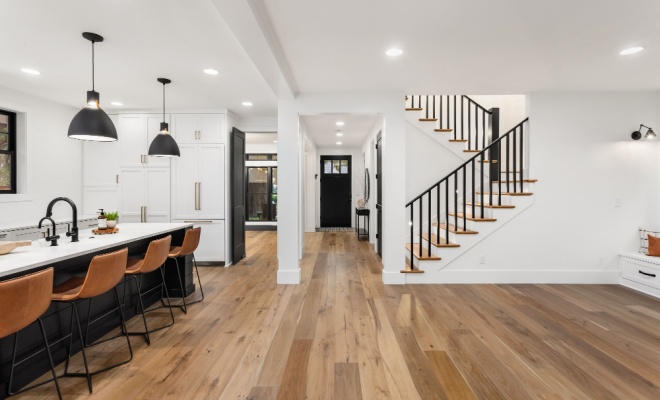
Load-bearing walls are also demolished when building a new extension, as you will need to create new doorways to enter and exit the new rooms. You can choose either a single or double doorway, as long as there is space available to accommodate it.
Will I Need a Lintel?
A lintel is a type of structural beam used to support the floors above including the roof when a new window or door is installed. The function of a lintel is to shift the weight of the load away from the above wall and move it to the side to maintain the original structure.
Lintels are a must for all window and door installations which cover a width of more than 600mm as well as all openings covering steel frames which are greater than 900mm. These are usually installed by a professional builder either by hand or crane, depending on the size.
They are normally placed in the small gap above a window or door to allow room for slight movement over time, especially with timber frames as this material tends to expand.
Lintel beams cost anywhere from £7 for small-scale lintels to £400 each for high-strength concrete lintels and £8 for smaller lintels to £1050 each for heavy-duty steel lintels.
What Can Go Wrong?
There are a number of things which could go wrong and increase the cost of removing a load bearing wall. This could include sagging ceilings which could cost anywhere from £400 to £1,000. If there is a lack of support for the floor above, this could cause unlevel flooring, which on average would cost around £15 to £18 per square metre to fix, although this will, of course, depend on the extent of the damage and the materials used.
There is also the possibility of cracks in the drywall, which costs around £10 to £15 per square metre to repair.
All of these problems can be avoided, as long as you use a reputable builder and liaise with building control, everything should be fine.
Alternatively, if you are planning to remove the wall yourself, use a structural engineer to advise you on the job, especially regarding the support (RSJ) required to ensure no problems.
Common Mistakes When Removing a Wall
As well as underestimating how much it can cost to knock down an internal wall, people can easily misjudge their own capabilities when thinking of it as a fun DIY job. Especially when it comes to knocking down a load-bearing wall, as the additional structural support required can compromise the stability of the whole property.
For load-bearing walls in particular, considering the cost of a structural engineer is recommended, along with any post-demolition inspection regardless of who's carried out the work.
It's also important with wall removal that adjacent walls and floors, or even the building next door, is taken into consideration. Especially when estimating the amount of structural support required.
Whether you're knocking down an internal wall yourself or hiring a professional, remember to check whether or not it's going to affect the electrical wiring or internal plumbing. Neglecting this could easily result in unexpected damage and add further costs to your project.
People can also find it tempting to skip official permits or required documentation. However, this can lead to potential fines or complications further down the line when buying or selling a property. If in doubt, it's always best to check with the local authorities first.
FAQs
That being said, knocking down internal walls isn't an activity that normally requires planning permission, unless a listed building. Never the less, a Building Regulations application must be made so Building Control can inspect the work and issue a completion certificate. In almost all cases consulting a structural engineer to design a suitable beam or supporting structure is highly recommended.
It is a common saying that you can tell if a wall is load-bearing just by tapping it and checking for a hollow sound. If hollow, it is a stud wall and can be removed without any support – unfortunately, it is not that easy! If you are unsure, the best thing to do is to consult a structural engineer or building surveyor to be on the safe side. Though in any case, you will need to consult Building Control.
If the wall you want removing is on the first floor of your house and you have a basement, you could check the ground level to see if there is a support wall or the beams are facing the same way, then it may be a load-bearing wall. If after all of this, you are unsure, you could ask a structural engineer or architect to inspect the wall to determine whether it is load-bearing.
How to Find & Hire a Load-Bearing Wall Contractor
When removing a load-bearing wall, it is important that you find the right people for the job to ensure that there are no problems. To start with, you should look for a qualified structural engineer who can help you remove your wall safety while ensuring building regulation are met.
For their services, you should expect to pay around £50 to £90 per hour, which may seem expensive but is definitely worthwhile in the long run. Before employing a structural engineer, you may want to check they have a civil engineering degree with a speciality in structural engineering, as this will ensure that they have the knowledge and skills to do the job.
Once all your plans are in place, you should seek out a reputable builder with extensive experience in removing load-bearing walls or demolition. The average rate for a professional builder is around £150 to £240 a day.
However, it may be more depending on your location as well as the size of the job. You may also want to hire a joiner to ensure the structure is fitted together properly and follows the structural engineering plans. The hourly rate for a joiner is usually around £10 to £22 per hour, although again this will depend on where you live and the job itself.
To finish off the job, you may want to bring in an experienced plasterer, who will charge around £150 to £200 per day to ensure your walls are prepared for redecorating.
You should also make sure that the tradesmen you choose all have public liability insurance to protect themselves and you in the event of damage or an incident.
Sources
https://www.gov.uk/building-regulations-approval
https://www.planningportal.co.uk/permission/common-projects/internal-walls/building-regulations-fire-safety
https://www.directline.com/home-cover/magazine/how-to-knock-down-a-wall
https://theconstructor.org/building/lintel-types-uses/11420/
https://www.beamcalculation.co.uk/checklist-for-removing-a-load-bearing-wall/










